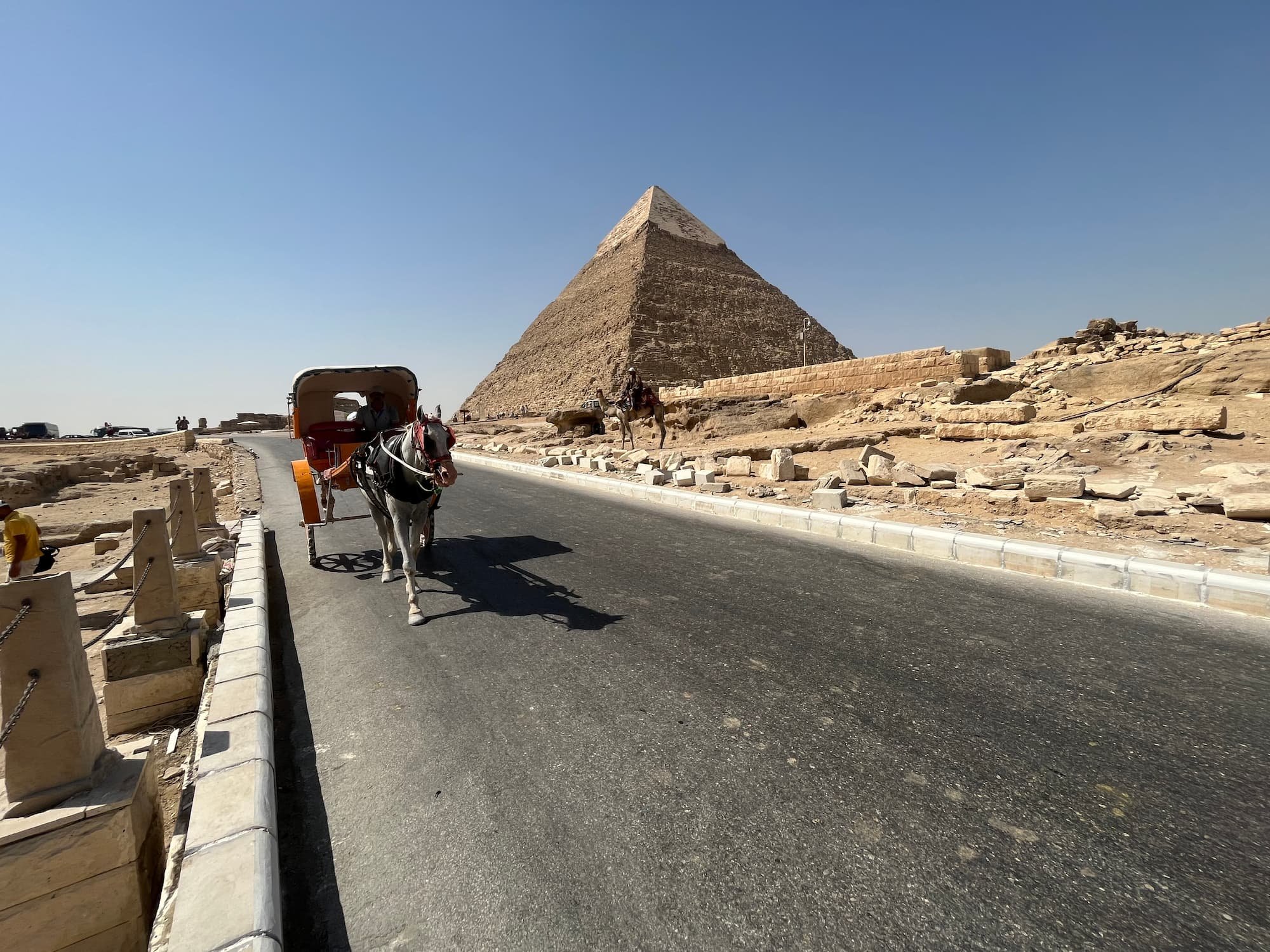The top 10 interesting facts about the Pyramids of Giza which I learned during my visit.
Pulling into the Giza Plateau was a surreal moment…
I was finally seeing the pyramids first hand, after decades of learning about them…
They really are special!
Learning some interesting facts about the Pyramids of Giza while being stood next to them was an awesome history lesson.
The myths surrounding the Giza Pyramids create vivid imagination for people around the world, but do they live up to expectation?
Here are 10 facts about the Giza Pyramids which help you decide whether you should book those flights to tick off the bucket list landmark.
Let’s start with the fascinating exteriors of the three pyramids.
The local forced me to do weird poses!
Changing Colours.
The pyramids' limestone exterior once had a smooth, white outer casing that reflected sunlight brilliantly. Over time, this casing eroded, revealing the yellowish core stones.
The original white limestone casing was quarried from Tura, a region across the Nile from Giza, and was prized for its fine grain and smooth texture, allowing the Egyptians to polish it to a brilliant shine.
Although it would have been amazing to have witnessed the beauty in ancient times, I feel as though seeing the rocks as they are today is far more impressive!
It is hard to imagine the skill that was needed to prize together such large and different shaped rocks.
Sitting on the giant rocks makes for a great Egyptian Instagram shot!
The stones of the Great Pyramid.
If you want to learn more about the ancient stone masonry, there are areas of the Egyptian Museum which detail the methods which would have been used.
It is definitely worth a visit!
The stones are epic.
More Than Giza.
While the Giza pyramids are the most famous, there are over 100 pyramids scattered throughout Egypt, each with its own unique history and features.
It is said that all three Giza pyramids were erected within around 70 years, over 4500 years ago, however, the Step Pyramid of Djoser at Saqqara is the oldest known stone pyramid, which was built nearly a century earlier.
I found the step design to be fascinating, and apparently, compared to the Giza pyramids smooth finish, it represents an earlier stage of architectural and engineering development of ancient Egyptian pyramid construction.
Regional Variations:
Pyramids weren't only built in the Giza region, and they were built throughout the Egyptian lands, with regional variations in size, style, and construction techniques. For instance, pyramids at Dahshur, south of Giza, have a more bent angle than the Giza pyramids.
The oldest pyramid in the world at Saqqara.
The vast network of pyramids across Egypt paints a more comprehensive picture of this ancient civilisation.
Each pyramid, with its unique characteristics and history, adds another piece to the puzzle, helping us understand the development, beliefs, and achievements of this remarkable culture.
I learned a lot about the famous burial landmarks on my solo Egyptian adventure!
Hidden Chambers?
There's ongoing speculation about the existence of hidden chambers within the pyramids. As the modern world improves its technologies, more intelligent forms of machinery can be used to explore ancient wonders such as the pyramids.
There are strong indications of anomalies inside the infrastructure of the pyramids which have been found through the use of muon tomography, which uses subatomic particles to create internal images.
Unfound chambers and structural features could be the cause!
On my visit to the pyramids I entered the Great Pyramid and Southern Pyramid but didn’t find much inside. I find it hard to believe that there won’t be many hidden parts full of treasure.
If you were to believe the movies though, such hidden chambers may be booby-trapped to protect the Pharaoh’s tomb and treasure.
So maybe it’s best we all just stick to riding camels around the Pyramids and marvelling at their beauty from afar!
Wandering the chambers of the Pyramids.
Not Built by Slaves.
Despite many people’s beliefs, there's no evidence that the ancient Egyptians used slaves to build the pyramids.
Skilled labourers, likely paid workers and farmers during off-seasons, are thought to have been the workforce.
When you walk around the famous temples in Egypt and see the exquisite architecture, it doesn’t make it too hard to believe that the ancient civilisations were very skilled, therefore, the pyramids might not have been built by slaves.
I still wonder how they were transported between the Egyptian cities though?
The aliens rumours are a more fun way of thinking!
Oldest Wonder.
The Great Pyramid of Giza is the oldest of the Seven Wonders of the Ancient World, and the only one still standing nearly intact. Construction likely began around 2560 BC, making it a monument that predates recorded history by a significant margin.
Even without sophisticated technology, the ancient Egyptians managed to construct a pyramid that remained the tallest structure in the world for nearly 4000 years.
The ancient wonder was built using an estimated 2.3 million blocks of stone in its construction, which is a testament to the scale and ambition of the architectural project.
The Egyptians developed ingenious techniques for quarrying, transporting, and precisely placing these enormous stones. The near-perfect alignment of the pyramid's sides and its overall stability demonstrate their remarkable engineering skills.
The Great Pyramids remain a powerful symbol of ancient Egypt and a source of wonder for people around the world.
The Sphinx's Riddle.
The Great Sphinx, a monumental limestone statue with a human head and a lion's body, stands guard in front of the Khafre Pyramid. The purpose and meaning behind the Sphinx remain a mystery.
Theories range from its role as a guardian to a representation of the pharaoh's power.
I found that the location of the Sphinx creates an aurora of protection, with it appearing to guard the three pyramids. It makes sense to me that it was apparently a protector of the tombs and the bodies of the pharaohs from evil spirits and grave robbers.
A lion is a symbol of strength and royalty, which embodies this protective role!
Throughout history, Egyptologists have believed that the Great Sphinx faces directly eastward on purpose, which is towards the direction of the rising sun.
This alignment has led some to believe it represents the sun god Ra, a central deity in Egyptian religion.
There are sphinx statues located throughout Egypt, however, none which are the size, stature, and are as globally recognisable as the Sphinx of Giza.
Horse & carriages are a popular way of traversing the Giza Plateau.
Alignment with the Stars.
The pyramids are aligned with incredible precision along cardinal directions (north, south, east, and west).
This alignment might reflect the Egyptians' fascination with astronomy and the afterlife, with the pyramids serving as a gateway to the heavens.
Some theories suggest that in ancient times, the Egyptians might have used simple tools like gnomons (vertical sticks) to track the sun's movement and determine north-south orientation. They could have also observed the stars to establish east and west.
Our tour guide told us that the precise alignment might have symbolised a pathway for the pharaoh's soul to ascend to the heavens and join the stars in the afterlife.
The Egyptians believed in a celestial afterlife, and the pyramids may have served as a physical manifestation of this belief.
The wonder of the pyramids certainly lives up to such a scenario.
A great importance was placed on order, maat (cosmic balance), and symmetry in the ancient world, and the perfect alignment of the pyramids could reflect these values, and their desire to create a structure in harmony with the universe.
There is no questioning the precise alignment of the pyramids, which will always remain a fascinating aspect of these ancient structures. It definitely highlights the Egyptians' sophisticated understanding of the natural world and their deep connection to the cosmos.
The pyramids aren’t the only ancient relics to visit.
There is no doubt that the Pyramids of Giza are the highlight of Egypt, however, Luxor and Aswan are also abundant with ancient relics.
If you head down to Luxor from Cairo, you can split the highlights of Luxor over two days.
East Bank highlights:
West Bank highlights:
Valley of the Queens.
Unfinished Obelisk.
Nubian Museum.
Gharb Soheil Nubian Village.
Robbed and Reused.
The pyramids were plundered for treasures over the centuries.
Historical records and archaeological evidence suggest multiple attempts at breaking into the pyramids to steal gold, jewellery, and other valuables believed to be buried with the pharaohs.
Some stones from the pyramids were even used in later construction projects in Cairo.
It is no surprise that most of the treasure was never seen again, however, you can actually view some of it in the various museums across Egypt.
For example, in the Egyptian Museum of Antiquities, items from tombs of nobles and workers who built the pyramids, are displayed.
Another unwillingly cringy pose that I got charged for.
Royal Neighbours.
The Giza pyramids are not alone.
Smaller pyramids for the pharaoh's wives and numerous mastabas (tombs) for officials and nobles surround them, creating a vast royal necropolis.
Although these smaller structures are nowhere near the size of the three main pyramids, they still would have signified very high status in ancient times.
These smaller pyramids often reflected the architectural style of the main pyramid they were associated with. Some notable examples include the three pyramids adjacent to the Khufu pyramid, believed to be for his wives. Queen Khentkaues' pyramid, the largest of the queen's pyramids at Giza, is a great example.
The Giza Necropolis offers a window into the vast social hierarchy and complex belief systems of ancient Egypt.
The presence of these various structures surrounding the pyramids paints a richer picture of the importance placed on the afterlife and the elaborate rituals associated with pharaohs and other members of the elite.
A camel chilling in front of a smaller ‘Queen’ pyramid.
Giza's Geographic Gift.
The pyramids were strategically built on a plateau made of natural bedrock, providing a stable and solid foundation for these enormous structures.
Wandering around the plateau, you would never guess the pyramids were nearly 5000 years old.
The structural foundation has stayed strong for thousands of years, as it comprises limestone, a naturally hard and stable sedimentary rock. This limestone has provided a much more secure base for the massive weight of the pyramids compared to sand or softer sedimentary rock.
The enormous weight of the structures has been distributed evenly across a large area due to the limestone’s rigidity.
The selection of the Giza plateau with its natural bedrock foundation was a clever and strategic decision by the ancient Egyptians, and it has paid off as the ancient wonders have survived the test of time remarkably.
One of the beautiful pyramids.
Are the Pyramids of Giza worth visiting?
So there you have it, some awesome ancient Egyptian facts about the Pyramids of Giza.
It really was a special moment as I pulled up to the Giza Plateau and spotted the Great Pyramid for the first time, and I couldn’t recommend it enough!
The hands-on history lesson of actually touching and seeing the true scale of the pyramids can’t be fully experienced through photos or videos.
I recommend that you begin your Egypt itinerary in the capital, as a few days in Cairo will allow you to tick off the Giza and Saqqara pyramids on some fun tours.
sdsdsds















